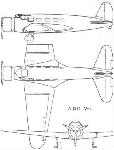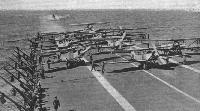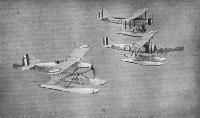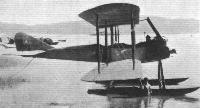Фотографии
-
THE FIAT C.R.30: The machine illustrated is the two-seater version which won the Bibesco Cup last year. Except for the cockpit arrangements the single-seater is similar.
Самолёты на фотографии: FIAT CR.30 / CR.32 Chirri - Италия - 1932
-
C.R.30
Самолёты на фотографии: FIAT CR.30 / CR.32 Chirri - Италия - 1932
-
Самолёты на фотографии: Dewoitine D.500 / D.510 - Франция - 1932
-
Dewoitine D.500
Самолёты на фотографии: Dewoitine D.500 / D.510 - Франция - 1932
-
Самолёты на фотографии: Junkers K 47 / A 48 - Германия - 1928
-
Регистрационный номер: X12293 FOR HIGH-SPEED TRANSPORT: The Airplane Development Corporation V-1 three-quarter front view.
Самолёты на фотографии: Vultee V-1A - США - 1933
-
A MODERN UNDERCARRIAGE: One-half of the retractable undercarriage. The tail wheel also is retractable.
Самолёты на фотографии: Vultee V-1A - США - 1933
-
A.D.C. V-I
Самолёты на фотографии: Vultee V-1A - США - 1933
-
A "HAWK" FOR IRELAND: Phillips &. Powis have just delivered this "Hawk" to Lady Nelson, of Everson Flying Services, Finglas. With the machine are Mr. J. R. Currie, chief ground engineer of the company, and Capt. Hamilton, who learnt to fly at this school.
Самолёты на фотографии: Miles Hawk / M.2 - Великобритания - 1932
-
Регистрационный номер: G-ABBB, K2227 FOR SHORT-WAVE WIRELESS TESTS: Marconi Type A.D. 43A transmitter installed in a Bristol "Bulldog" single-seater fighter for recent short-wave tests between the Marconi experimental station at Croydon and the aeroplane in flight over the Bristol district. The corresponding receiver, Type A.D. 44A, is mounted at the back of the transmitter. This photograph shows the method of installation, the aerial system, and the Marconi-Stanley one-horse-power engine and flexible drive used for running up the generator on the ground for testing and adjusting purposes.
Самолёты на фотографии: Bristol Bulldog - Великобритания - 1927
-
THE FARMAN 220 BOMBER: Three-quarter front view.
Самолёты на фотографии: Farman F.220 / F.221 / F.222 - Франция - 1932
-
NATIONAL RECOGNITION: An air display, organised by the Aero Club of Spain, was given in Madrid recently in honour of Juan de la Cierva, and to celebrate the award to the latter of the F.A.I. 1933 Gold Medal. Here we see Senor de la Cierva giving a display, at the Barajas Military Aerodrome, in the C.30 type Autogiro.
Самолёты на фотографии: Cierva/Avro C.30A / Rota - Великобритания - 1932
-
MILITARY LOAD: The Breguet 27 is not of new design, but during the past two or three years it has been continually improved. Here we see it in its latest form - fitted with a Gnome-Rhone "Mistral Major" 14 KRSd supercharged two-bank radial, which gives well over 1,000 h.p. for take off, and is rated at 815 h.p. at 2,390 r.p.m. at 7,150 ft. As a reconnaissance machine or as a bomber, the "27" is equally efficient. In the latter form, a bomb load of about 1,840 lb. may be carried. The performance figures for the Gnome-Rhone-engined version are not available for publication, but when the "27" is fitted with the Hispano-Suiza 12 Ybrs water-cooled engine of 850 h.p., it has a maximum speed of about 186 m.p.h., climbs to 16,375 ft. in about 9 minutes and has a ceiling of over 30,000 ft. - not, of course, carrying the maximum permissible bomb load. The Breguet 27 A2, fitted with a 500-h.p. Hispano-Suiza engine, is a standard type in the French Armee de l'Air.
Самолёты на фотографии: Breguet Br.270 / Br.330 - Франция - 1929
-
FAIREYS AT THE BOTTOM OF THE GARDEN: This photograph, taken on board the aircraft carrier Courageous during the Spring Cruise in the Mediterranean, is of interest not only on account of the large number of Fairey machines ranged on the flying deck, but also because at the back, over the extreme stern, may be seen the Supermarine "Seagull Mark V" with Bristol "Pegasus" engine. The presence of the latest type of amphibian flying boat on board the carrier may be significant.
Самолёты на фотографии: Fairey Gordon / Seal - Великобритания - 1931Supermarine Walrus/Seagull V - Великобритания - 1933
-
Регистрационный номер: S1679 A FLIGHT OF THE SEAPLANE TRAINING SQUADRON: "Osprey" and "Seal" led by "Tutor."
Самолёты на фотографии: Avro Tutor/Sea Tutor/Prefect / Type 621/646/626 - Великобритания - 1929Fairey Gordon / Seal - Великобритания - 1931Hawker Osprey - Великобритания - 1930
-
CRAFT OF THE SEAPLANE TRAINING SQUADRON: The machines from left to right are Fairey "Seal," Avro "Tutor," Saro "Cloud," Hawker "Osprey" and Supermarine "Southampton."
Самолёты на фотографии: Avro Tutor/Sea Tutor/Prefect / Type 621/646/626 - Великобритания - 1929Fairey Gordon / Seal - Великобритания - 1931Hawker Osprey - Великобритания - 1930Saunders-Roe Cloud / A.19 - Великобритания - 1930Supermarine Southampton / Solent - Великобритания - 1925
-
Самолёты на фотографии: Saunders-Roe Cloud / A.19 - Великобритания - 1930
-
Регистрационный номер: K2898 Saro "Cloud" (two Siddeley "Serval").
Самолёты на фотографии: Saunders-Roe Cloud / A.19 - Великобритания - 1930
-
THE AMPHIBIAN GEAR: Note that when in the raised position the wheel is completely housed in a recess in the wing.
Самолёты на фотографии: Supermarine Walrus/Seagull V - Великобритания - 1933
-
GOING - GOING - GONE: The "Seagull V" catapulted at Farnborough. The first picture shows the machine being drawn up the slope to the catapult. Then comes a picture showing the claws which secure the machine.
Самолёты на фотографии: Supermarine Walrus/Seagull V - Великобритания - 1933
-
GOING - GOING - GONE: In the next all is in readiness for launching by the catapult, and finally the "Seagull V" is seen just as it leaves the catapult, piloted by Flt. Lt. S. R. Ubee.
Самолёты на фотографии: Supermarine Walrus/Seagull V - Великобритания - 1933
-
Самолёты на фотографии: Supermarine Walrus/Seagull V - Великобритания - 1933
-
IN THE MEDITERRANEAN: The Supermarine "Seagull V" being hoisted on board the aircraft carrier Courageous.
Самолёты на фотографии: Supermarine Walrus/Seagull V - Великобритания - 1933
-
FOR STOWAGE: The "Seagull V" with wings folded. Note the small folded width.
Самолёты на фотографии: Supermarine Walrus/Seagull V - Великобритания - 1933
-
THE "SEAGULL V": This side view gives a good idea of the general lines of the machine. The view from the pilot's cabin is particularly good.
Самолёты на фотографии: Supermarine Walrus/Seagull V - Великобритания - 1933
-
CLEAN FRONTS: These two views of the "Seagull V" on the sea and on land show the care taken to reduce drag.
Самолёты на фотографии: Supermarine Walrus/Seagull V - Великобритания - 1933
-
Регистрационный номер: X223Y Был построен только один DC-1, и фирма "Douglas" потеряла 306 778 долларов собственных средств на создание и испытания этого самолета. Тем не менее, он расчистил путь для самолетов мирового класса DC-2 и DC-3.
A Douglas D.C.1 "Transport" as supplied to Transcontinental & Western Air, Inc.Самолёты на фотографии: Douglas DC-1 / DC-2 / C-32 / C-39 - США - 1933
-
WAITING TO GO: Seven "Tiger Moths" and one "Dragon" at Hatfield, ready to start for Copenhagen. The Danish crews include Capt. C. C. Larsen, Lts. Clausen, Meincke and Rydman, Sgts. Eriksen, Petersen and Hansen, and Machine Officer Petersen.
Самолёты на фотографии: De Havilland Dragon / D.H.84 - Великобритания - 1932De Havilland Tiger Moth / D.H.82 - Великобритания - 1931
-
Регистрационный номер: G-ACND [5] FAST TOURING: A glimpse of the "Mew Gull" flying past, with its designer at the controls.
The prototype Mew Gull, G-ACND, was originally powered by a Napier Javelin but later reengined with a 200 h.p. Gipsy Six.Самолёты на фотографии: Percival Mew Gull - Великобритания - 1934
-
Регистрационный номер: G-ACND [5] ROOM ENOUGH: In spite of the small size of the machine, there is room in the cabin for a large pilot (in this case Mr. Percival himself) wearing his parachute. The luggage locker is in the tail fairing.
Самолёты на фотографии: Percival Mew Gull - Великобритания - 1934
-
Регистрационный номер: G-ACND [5] PREPARING FOR THE FIRST FLIGHT: Mr. Percival may be seen on the right, donning his parachute before taking the "Mew Gull" up in a gale.
Самолёты на фотографии: Percival Mew Gull - Великобритания - 1934
-
Регистрационный номер: G-ACND [5] This view of the machine indicate that in spite of the location of the cabin, the view diagonally forward is quite good.
Самолёты на фотографии: Percival Mew Gull - Великобритания - 1934
-
Регистрационный номер: G-ACND [5] 200 M.P.H.: Mr. E. W. Percival demonstrated his latest machine, the "Mew Gull" (Napier "Javelin"), in a gale last week.
Самолёты на фотографии: Percival Mew Gull - Великобритания - 1934
-
OVER HANWORTH: Mr. E. G. Hordern flying the Salmson-engined British Klemm "Swallow" in front of the club hangar at Hanworth.
Самолёты на фотографии: Klemm L.25 - L.28 Swallow - Германия - 1927
-
Регистрационный номер: G-ACMK NEAR THE GROUND: Its excellent manoeuvrability enables the Klemm to be flown so that pictures may be obtained from the ground like this.
Самолёты на фотографии: Klemm L.25 - L.28 Swallow - Германия - 1927
-
FOR EASY HANDLING: A good view which shows the lever for withdrawing the front wing joint pins and also the catch in the leading edge making wing folding a one-man job.
Самолёты на фотографии: Klemm L.25 - L.28 Swallow - Германия - 1927
-
A view showing the newly-designed, sturdy undercarriage.
Самолёты на фотографии: Klemm L.25 - L.28 Swallow - Германия - 1927
-
A CLEAN FRONT: Large wing area and low wing loading give this Pobjoy-engined British Klemm "Swallow" a spectacularly low landing speed.
Самолёты на фотографии: Klemm L.25 - L.28 Swallow - Германия - 1927
-
Регистрационный номер: X233Y IN FULL FLIGHT: The Lockheed "Electra" makes its maiden flight at Burbank, California, on February 23.
Самолёты на фотографии: Lockheed Electra 10 - США - 1934
-
Регистрационный номер: NC822M FOR TRANSATLANTIC SERVICE?: The Sikorsky S.42 four-engined flying boat recently completed for Pan-American Airways. After tests it will be put into service between the United States and South America, and subsequently may be used for transatlantic service.
Самолёты на фотографии: Sikorsky S-42 Clipper - США - 1934
-
THE GOLD SEEKERS: The two D.H "Dragons," Golden West and Gay Prospector, employed for Surveying gold-mining areas in Western Australia.
Самолёты на фотографии: De Havilland Dragon / D.H.84 - Великобритания - 1932
-
A BUSINESS TRIP: Officials of Pass & Joyce, distributors of Talbot cars in London and Home Counties, recently made a tour of inspection of their area in a "Dragon" belonging to Olley Air Services, and are shown here in our picture. The group includes Capt. Olley, who is standing in the doorway of the 'plane, and shaking hands with Mr. A. H. Pass. Next to Mr. Pass are his co-directors, Mr. C. J. Joyce and Mr. S. H. Devey, while Capt. C. R. F. English, the manager of Pass & Joyce, is next in line, slightly behind Mr. Devey.
Самолёты на фотографии: De Havilland Dragon / D.H.84 - Великобритания - 1932
-
FILMING THE ENGLAND-AUSTRALIA AIR ROUTE: Mr. Roy Tuckett (left) and Mr. John Chapman (photographer), who are flying out to Koepang for the purpose of filming sections of the England-Australia air route. Their "Puss Moth" has been specially equipped with aerial film cameras, and the Vacuum Oil Co. have made all arrangements en route for fuel and oil supplies..
Самолёты на фотографии: De Havilland Puss Moth / D.H.80 - Великобритания - 1929
-
ON THE SLIPWAY: An "Osprey" is about to be beached, and airmen are arranging the trolleys under the floats.
Самолёты на фотографии: Hawker Osprey - Великобритания - 1930
-
УТС начального обучения "тип 1-1", построенный на авиастанции в Сучжоу (1922г.)
THE "CHAR": A two-seater open cockpit primary training seaplane. It is fitted with a 100-h.p. Curtiss water-cooled V engine.Самолёты на фотографии: Xuzhou Air Station Type 1-1 Char / Type 2-1 Yee - Китай - 1922
-
THE "YEE": This is a two-seater open cockpit advanced training seaplane, fitted with a 100-h.p. Hall-Scott water-cooled engine.
Самолёты на фотографии: Xuzhou Air Station Type 1-1 Char / Type 2-1 Yee - Китай - 1922
-
The executive staff of the Naval Air Establishment at Lungwha, Shanghai. Left to right: Capt. Tseng Yee-king, B.Sc. (present Director-General); Capt. Barr Yu-tsao, M.Sc; and Capt. Wong Tsoo, M.Sc, A.F.R.Ae.S.
Самолёты на фотографии: Xuzhou Air Station Type 3-1 Chiang Hung / Type 5-1 Wu - Китай - 1924
-
A FLOATING HANGAR: Designed by Capts. Barr and Wong, this is of steel construction and is partly submersible so that the seaplane can be taxied in or out of its hangar.
Самолёты на фотографии: Xuzhou Air Station Type 3-1 Chiang Hung / Type 5-1 Wu - Китай - 1924
-
THE "DING": A bomber or passenger seaplane. It has two open cockpits and a cabin with accommodation for four. The engine is a 360-h.p. Rolls-Royce.
Самолёты на фотографии: Xuzhou Air Station Type 4-1 Ding (Морской орел) - Китай - 1928
-
THE "BEENG": A single-engined (360-h.p. Rolls-Royce) biplane flying boat, military bombing or commercial. It has three open cockpits and a cabin seating four.
Самолёты на фотографии: Xuzhou Air Station Type 6-1 Beeng (Морской гусь) - Китай - 1930
-
UNUSUAL MARKINGS: An Armstrong-Whitworth "Atlas II" ("Panther IIa") supplied to China. On the port top plane is the squadron marking. The national marking is carried on the starboard wing.
Самолёты на фотографии: Armstrong Whitworth Atlas / Ajax - Великобритания - 1925
-
A SUITABLE SIGN: Used as "a memorial to past achievement and an inspiration to further endeavour," the original "Tiger Moth" and holder of world records, is now to be seen attracting people to the site of the new D.H. factory at Hatfield.
Самолёты на фотографии: De Havilland Tiger Moth / D.H.71 - Великобритания - 1927
-
В открытых кабинах самолета P-16, расположенных тандемом, размещались летчик и наблюдатель-стрелок.
Самолёты на фотографии: Berliner-Joyce P-16 / PB-1 - США - 1929
-
THE BERNARD 52 C I before proceeding to St. Raphael for official tests.
Самолёты на фотографии: Bernard H.52 / H.110 - Франция - 1933
-
Bernard 52 C 1
Самолёты на фотографии: Bernard H.52 / H.110 - Франция - 1933
-
THE GEEBEE "INTERNATIONAL SUPERSPORTSTER": An American design for the England-Australia race.
Самолёты на фотографии: Gee Bee Model Z/R Super Sportster - США - 1931
-
FROM PERU: A Panair (Pan-American Airways) Consolidated "Commodore" arrives at Para from New York. This photo was taken by Miss Winifred Brown during her visit to S. America and Upper Amazon - on which subject she is now giving a series of lectures.
Самолёты на фотографии: Consolidated Commodore / PY Admiral - США - 1929
-
Регистрационный номер: J-BBJI IMITATION THE SINCEREST FORM OF FLATTERY: This machine, known as the "Chidorigo," was constructed by the Tokio Gas & Electric Industry Co., and is remarkably like a D.H. "Fox Moth" - although the company is in no way associated with the de Havilland Co. It is fitted with a 7-cyl. 150 h.p. Gasden "Zimpu" (which, again, closely resembles the Armstrong-Siddeley "Mongoose"). It is being used by the Japan Aerial Transport Co. for taxi and joy-riding purposes. A brief specification of this machine is as follows :- Span, 9 ft. 2 in.; wing area, 236.7 sq. ft.; weight empty, 1,212.75 lb.; laden weight, 2,116.8 lb.; speed range, 46-122 m.p.h.; range, 404 miles.
Самолёты на фотографии: De Havilland Fox Moth / D.H.83 - Великобритания - 1932
-
THE FOKKER D.XVII: This is the "Kestrel"-engined version supplied to the Dutch Army Air Force
Самолёты на фотографии: Fokker D.XVII - Нидерланды - 1932
-
THE FOKKER D.XVII: This drawing shows the machine fitted with a Curtiss "Conqueror" engine. Later versions have the "Kestrel," Hispano-Suiza 12 Xbrs or Lorraine "Petrel."
Самолёты на фотографии: Fokker D.XVII - Нидерланды - 1932
-
Регистрационный номер: PH-AEH THE SAME THING, ONLY DIFFERENT: On the top is a Fokker F.VIII (2 Bristol "Jupiters") in its original form. Below it is seen equipped with two Wright "Cyclone" F/R1826 engines, mounted in the leading edge of the wings.
Самолёты на фотографии: Fokker F.VIII - Нидерланды - 1927
-
The Liore et Olivier 24-2
Самолёты на фотографии: Liore et Olivier LeO H.24 / H.27 - Франция - 1929
-
The Martin 121 flying boat as a twin-engined machine.
Самолёты на фотографии: Martin P2M / P3M - США - 1930
-
THE MARTIN 121 flying boat as fitted with three engines.
Самолёты на фотографии: Martin P2M / P3M - США - 1930
-
ON THE SLIPWAY: A "Southampton" is being launched
Самолёты на фотографии: Supermarine Southampton / Solent - Великобритания - 1925
-
ON THE SLIPWAY: Airmen are receiving instruction in mooring tackle.
Самолёты на фотографии: Supermarine Southampton / Solent - Великобритания - 1925
-
Регистрационный номер: F-AMRA A French Tourer: The Potez 58
Самолёты на фотографии: Potez Potez 43 / 58 - Франция - 1932
-
Stinson Model A
Самолёты на фотографии: Stinson Model A - США - 1934
-
Самолёты на фотографии: SPCA Type 30 - Франция - 1931
-
A GUERNSEY GLIDER: The "Scud I" which is used by the Guernsey Gliding Club at St. Peter Port. The club propose to build a similar machine.
Самолёты на фотографии: Abbott-Baynes Scud - Великобритания - 1931
-
WHERE IS THE MOAT? Here we see the latest development of the type A.B.21 bomber manufactured by the Societe Aerienne Bordelaise. The machine, which has a span of over 120 ft., is fitted with four Lorraine "Petrel" engines.
Самолёты на фотографии: Dyle et Bacalan / SAB AB-20 / AB-21 - Франция - 1932
-
OUT IN THE OPEN: Erecting the Short "Scylla" at the new aerodrome, Rochester, where no hangars have yet been built. The work of building the hangar and erecting the machine are proceeding simultaneously. The men holding the Dunlop wheel give an idea of the size of the "Scylla," which is the first of a batch of machines being built for Imperial Airways, Ltd.
Самолёты на фотографии: Short Scylla / L.17 - Великобритания - 1934
-
TAKING SHAPE: The Short "Scylla" (four Bristol "Jupiters") being erected in the open at the Rochester aerodrome. The boisterous weather during the last week or two has interfered greatly with the work, but it is expected that the machine will make its first flight this week.
Самолёты на фотографии: Short Scylla / L.17 - Великобритания - 1934
-
FROM ROUMANIA: This interesting machine, or "avionette," has been designed and constructed by D. Mihail, of Bucharest. Named the "Stabiloplan IV," it is fitted with an A.B.C. "Scorpion Mark II" engine, and a successful private test has already been accomplished. Official tests are to be made later.
Самолёты на фотографии: Mihail Stabiloplan IV - Румыния - 1933
-
Регистрационный номер: X962Y UNORTHODOX: The Lockheed "Alcor," similar in general design to the "Vega," has two "Menasco" engines mounted crankcase to crankcase across the nose of the fuselage. The resistance is claimed to be about half that of the normal radial engine installation.
Самолёты на фотографии: Alcor Duo-4 / Duo-6 - США - 1930
-
A JAPANESE LIGHT PLANE: The Itoh high-wing 2-seater monoplane, constructed by the Itoh Aeroplane Factory of Chiba, near Tokio, and equipped with a 40 h.p. British Salmson engine. It is used by the Japan Light 'Plane Club, an unsubsidised concern organised by a pioneer of Japanese aviation, Baron Narebara.
Самолёты на фотографии: Itoh Emi 50 Sport Aeroplane - Япония - 1933
-
The I.A.R.22 Trainer
Самолёты на фотографии: IAR IAR-22 - Румыния - 1934
-
I.A.R.22
Самолёты на фотографии: IAR IAR-22 - Румыния - 1934
Статьи
- Flight













































































